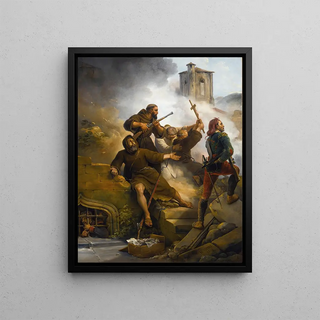Art print | The Siege of Zaragoza - Horace Vernet


View from behind

Frame (optional)
Reproduction of The Siege of Saragossa - Horace Vernet – Engaging Introduction
In the captivating world of art, some works transcend the mere frame of painting to become vibrant historical testimonies. "The Siege of Saragossa" by Horace Vernet is one such creation that captures not only a moment in history but also the very essence of human emotion. The scene depicted, rich in detail and intensity, transports the viewer to the heart of a significant military event from the early 19th century. Through this painting, Vernet invites us to contemplate the courage and determination of men in the face of adversity, while immersing us in an atmosphere charged with tension and drama.
Style and uniqueness of the work
Horace Vernet's style is distinguished by his ability to combine realism and romanticism. In "The Siege of Saragossa," the artist uses vivid colors and striking contrasts to emphasize the emotions of the characters. The faces, marked by suffering and bravery, are rendered with precision that reflects meticulous observation of human nature. Every detail, from uniforms to expressions, is carefully crafted, creating a scene that seems almost alive. Vernet succeeds in capturing the movement and energy of the battle, making the work dynamic and captivating. This approach, both dramatic and realistic, allows the viewer to feel the anxiety and hope of the besieged, making this painting a true immersion into history.
The artist and his influence
Horace Vernet, born in 1789, is one of the most emblematic painters of the 19th century, known for his depictions of military and historical scenes. His work is marked by a desire to pay tribute to the significant events of his time, while celebrating the courage of men. Vernet established himself as a master in the art of history painting, influencing many contemporary and future artists. His unique style, blending technical precision with raw emotion, paved the way for a new approach to representing conflicts. By exploring themes such as heroism and sacrifice, he contributed to shaping the collective memory of his era, making him a

Matte finish

View from behind

Frame (optional)
Reproduction of The Siege of Saragossa - Horace Vernet – Engaging Introduction
In the captivating world of art, some works transcend the mere frame of painting to become vibrant historical testimonies. "The Siege of Saragossa" by Horace Vernet is one such creation that captures not only a moment in history but also the very essence of human emotion. The scene depicted, rich in detail and intensity, transports the viewer to the heart of a significant military event from the early 19th century. Through this painting, Vernet invites us to contemplate the courage and determination of men in the face of adversity, while immersing us in an atmosphere charged with tension and drama.
Style and uniqueness of the work
Horace Vernet's style is distinguished by his ability to combine realism and romanticism. In "The Siege of Saragossa," the artist uses vivid colors and striking contrasts to emphasize the emotions of the characters. The faces, marked by suffering and bravery, are rendered with precision that reflects meticulous observation of human nature. Every detail, from uniforms to expressions, is carefully crafted, creating a scene that seems almost alive. Vernet succeeds in capturing the movement and energy of the battle, making the work dynamic and captivating. This approach, both dramatic and realistic, allows the viewer to feel the anxiety and hope of the besieged, making this painting a true immersion into history.
The artist and his influence
Horace Vernet, born in 1789, is one of the most emblematic painters of the 19th century, known for his depictions of military and historical scenes. His work is marked by a desire to pay tribute to the significant events of his time, while celebrating the courage of men. Vernet established himself as a master in the art of history painting, influencing many contemporary and future artists. His unique style, blending technical precision with raw emotion, paved the way for a new approach to representing conflicts. By exploring themes such as heroism and sacrifice, he contributed to shaping the collective memory of his era, making him a






